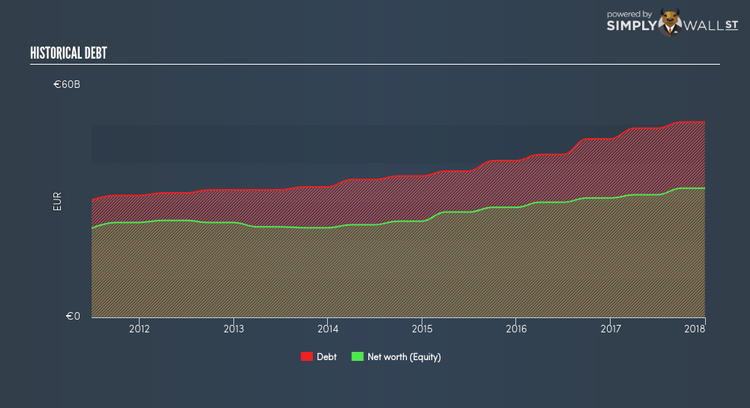Are Renault SA’s (EPA:RNO) Interest Costs Too High?

There are a number of reasons that attract investors towards large-cap companies such as Renault SA (ENXTPA:RNO), with a market cap of €25.28B. Doing business globally, large caps tend to have diversified revenue streams and attractive capital returns, making them desirable investments for risk-averse portfolios. However, the health of the financials determines whether the company continues to succeed. Let’s take a look at Renault’s leverage and assess its financial strength to get an idea of their ability to fund strategic acquisitions and grow through cyclical pressures. Note that this commentary is very high-level and solely focused on financial health, so I suggest you dig deeper yourself into RNO here. View our latest analysis for Renault
How does RNO’s operating cash flow stack up against its debt?
RNO’s debt levels surged from €46.23B to €50.59B over the last 12 months , which is made up of current and long term debt. With this increase in debt, RNO’s cash and short-term investments stands at €15.50B , ready to deploy into the business. On top of this, RNO has generated cash from operations of €5.70B in the last twelve months, leading to an operating cash to total debt ratio of 11.27%, meaning that RNO’s debt is not appropriately covered by operating cash. This ratio can also be interpreted as a measure of efficiency as an alternative to return on assets. In RNO’s case, it is able to generate 0.11x cash from its debt capital.
Does RNO’s liquid assets cover its short-term commitments?
At the current liabilities level of €66.24B liabilities, it seems that the business has been able to meet these obligations given the level of current assets of €67.51B, with a current ratio of 1.02x. For Auto companies, this ratio is within a sensible range since there is a bit of a cash buffer without leaving too much capital in a low-return environment.
Can RNO service its debt comfortably?
Renault is a highly levered company given that total debt exceeds equity. This is not unusual for large-caps since debt tends to be less expensive than equity because interest payments are tax deductible. Consequently, larger-cap organisations tend to enjoy lower cost of capital as a result of easily attained financing, providing an advantage over smaller companies. We can test if RNO’s debt levels are sustainable by measuring interest payments against earnings of a company. A company generating earnings before interest and tax (EBIT) at least three times its net interest payments is considered financially sound. In RNO’s case, the ratio of 10.42x suggests that interest is amply covered. It is considered a responsible and reassuring practice to maintain high interest coverage, which makes RNO and other large-cap investments thought to be safe.
Next Steps:
RNO’s cash flow coverage indicates it could improve its operating efficiency in order to meet demand for debt repayments should unforeseen events arise. However, the company exhibits an ability to meet its near-term obligations, which isn’t a big surprise for a large-cap. I admit this is a fairly basic analysis for RNO’s financial health. Other important fundamentals need to be considered alongside. You should continue to research Renault to get a better picture of the stock by looking at:
Future Outlook: What are well-informed industry analysts predicting for RNO’s future growth? Take a look at our free research report of analyst consensus for RNO’s outlook.
Valuation: What is RNO worth today? Is the stock undervalued, even when its growth outlook is factored into its intrinsic value? The intrinsic value infographic in our free research report helps visualize whether RNO is currently mispriced by the market.
Other High-Performing Stocks: Are there other stocks that provide better prospects with proven track records? Explore our free list of these great stocks here.
To help readers see pass the short term volatility of the financial market, we aim to bring you a long-term focused research analysis purely driven by fundamental data. Note that our analysis does not factor in the latest price sensitive company announcements.
The author is an independent contributor and at the time of publication had no position in the stocks mentioned.

